Impact Factor : 0.548
- NLM ID: 101723284
- OCoLC: 999826537
- LCCN: 2017202541
Torres A*1, Blanco A2, Coscujuela A3, Fernandez Fairén M4, Sevilla P5 and Gil FJ5,6
Received: January 24, 2018; Published: February 02, 2018
Corresponding author: Torres A, Hospital Universitario Santa Lucía. Calle Mezquita, s/n, 30202 Cartagena, Murcia, Spain
DOI: 10.26717/BJSTR.2018.02.000722
Background: Ceramic-on-ceramic (CoC) bearings have been in use in total hip replacement (THR) for more than 40 years, with excellent long-term survivorship but concerns over the ceramic-on-ceramic bearings wear persist.There are few studies where they analysed the ceramic-on-ceramic implants retrieved. We wanted to investigate the wear patterns and the surface properties of the CoC first generation THR implants removed.
Case description: We have analysed two cases of ceramic head on ceramic liner of Autophor primary THA implanted in active patients and retrieved for aseptic loosening after 34 and 31 years of well function.The sphericity, surface roughness and microtopography was assess by a profilometer and a white light interferometer Scanning electron microscopy of the implant-retrieved surfaces was also perform.
Clinical relevance: There is not a published study where retrieved implants of first generation CoC THR after more than 30 years of being implant were analyse. With the results obtained in our study, we have seen that the wear rate of ceramic-on-ceramic THA bearings, even those of the first generation, is low enough to allow a prolonged durability of the implants and offers a long-term survival of the arthroplasty.
Total hip replacement is one of the most successful surgical procedures. Ceramic-on-ceramic (CoC) bearings for total hip replacement (THR) were develop in the early 1970s. The earliest designs failed of inadequate fixation and high fracture rates [1,2]. Outstanding tribological properties of ceramic-ceramic bearings made them an important election as an ideal implant for younger patients undergoing THR [3-5]. Ceramic-on-ceramic bearings have shown the smallest wear volume in in vitro and in vivo studies [6,7]. The Mittelmeier Autophor™ cementless ceramic arthroplasty (Smith and Nephew, Memphis, TN) with ceramic- on-ceramic bearings of Biolox alumina (Feldmfiehle, Plochingen,Germany) was develop in 1974 and widely used around the 1980s. The Mittelmeier Autophor™ reduced the fracture rate but not the loosening [1,3,8-10].
The survival rate of this prosthesis was 98% after 17 years and the cause of their surgical revisions was the loosening of the implants [5]. Newer ceramic materials (Biolox Delta; CeramTec AG, Plochingen, Germany) [11] have been modified to reduce the risk of wear rate compared to alumina and Biolox or Biolox Forte.Modern implants of CoC THR have shown an excellent survivorship up to 97% at 10 years [10]. Long-term retrieval analyses of CoC THR show higher wear rates [12-15] that the ones obtained in vitro with hip simulators [16-19]. Those long-term retrieval analyses of CoC THR published studies [12-14] wasmake with implants removed after less than 20 years of being implanted. There is not a published study where retrieved implants of first generation CoC THR after more than 30 years of being implant were analyse.
We have analysed two cases of ceramic head on ceramic liner of Mittelmeier Autophor CoC THRs implantedin the 1980s through a posterior approach in active patients and retrieved after 34 and 31 years of well function. Bearings were made from an aluminum oxide ceramic with content of 99.7% Al2 03, a maximum grain size of 4μm, a mean grain size of 4.2μm and a density of 3.94 g/ cm3. The prostheses were from 1 men (77 years) and 1 women (68 years) at the implant retrieval moment. The reasons for hip arthroplasty were primary osteoarthritis secondary to developmental dysplasia in both cases. The indication for revision surgery was aseptic loosening. The head of the clinical case 1 was a first-generation mushroom-like head with a diameter of 38 mm. The head of the clinical case 2 was a neckless ceramic ball with 32mm of diameter. The retrieved implants were analysed visually to determine the obvious areas of wear. The sphericity, surface roughness and microtopography of the implants retrieved was assess by a profilometer and a white light interferometer Veeco. A scanning electron microscopy of the surfaces was also perform. The samples were examined with an Environmental Scanning Electron Microscopy, Electroscan 2020, including a thermoelectric cooling stage which allowed ± 20°C variations in temperature compared to room temperature.
The gas used was water vapour at 5-10 Torr and the temperature was between 5 and 7°C in order to keep the samples hydratated for as long as possible. White light interferometry (Wyko NT1100 Optical Interferometer, Veeco Instruments, USA), in its vertical scanning interferometry mode, was used to produce, evaluate and quantify the topography. The interferometric technique is ideal for imaging these surfaces as a large area of the surface can be imaged with a high vertical resolution (≈2nm). The analysis area was 124.4 x 94.6μm. Data analysis was performed with Wyko Vision 32 (Veeco Instruments, USA) which allows the application of a Gaussian filter to separate waviness and form from roughness.
Figure 1: Clinical case 1: Macroscopic wear of the retrieved CoC THR first generation retrieved liner.
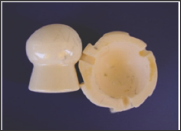
Figure 2: Clinical case 1: Macroscopic wear of the retrieved CoC THR first generation retrieved femoral head.
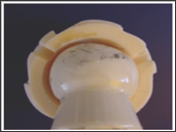
Figure 3: Clinical case 2: Macroscopic wear of the retrieved CoC THR first generation retrieved femoral head.
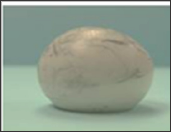
Figure 4: Clinical case 2: Macroscopic wear of the retrieved CoC THR first generation retrieved liner.
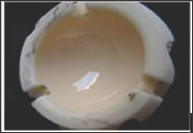
The femoral heads showed stripe wear and varying degrees of roughened or darkened areas (Figures 1-4). Surface topography of the femoral heads and acetabular cups showed that the unworn areas had a very smooth surface, but the roughened and areas with stripe wear had more peaks and troughs.The calculated lineal wear of the first clinical case head was 41.4μm/year. On the second clinical case, the estimated lineal wear was 48.3μm/year for the head and 18.5μm/year for the socket. Microscopic wear was assess by quantifying the surface roughness of liners and femoral heads. The average surface roughness was of 549.76±91.25 nm for the head of the first clinical case and 449.96±141.72 nm for the head of the second one in the worn areas. The average surface roughness in the unworn areas was 93.35±70.90 nm for the first clinical case and 79.89±88.97 for the second one. The SEM examination showed abrasive wear .The maximum deviation of the sphericity observed was 3.7% in the head and 2.9% in the socket on the clinical case 1.
Figure 5: The black lines on the surface of the ceramic have been analysed by X-Ray microanalysis of the black lines situated on the ceramic surface; they are produced by the wear in morse-cone with the wear metal-metal, the particles migrate to the ceramic-ceramic surfaces and the metallic debris are embebbed on the ceramic surface.
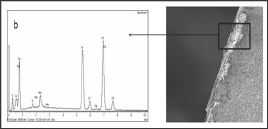
For the clinical case 2, the bigger sphericity deviation was 4.7% in the head and 1.8% in the socket, cracking of the surface with wear marks and alumina particles dislodging of small holes. The black lines on the surface of the ceramic have been analysed by X-Ray microanalysis. The results showed the presence of CoCrMo (MIRAR SI LOS VASTAGOS SON DE Ti6Al4V), these debris are produced by the wear in morse-cone with the wear metal-metal, the particles migrate to the ceramic-ceramic surfaces and the metallic debris are embebbed on the ceramic surface, as can be observed in (Figure 5).
Ceramic-on-ceramic bearings have shown to produce the smallest amount of wear volume in in vitro and in vivo studies [6]. However, concerns over ceramic wear, ceramic fracture and catastrophic failures persist and are report in the literature [2026]. Fewer cases of osteolysis have been reported [8,9,27,28] and fractures rates of modern alumina ceramic bearings published are as low as 1 in 25.000 [9,10,29]. The accepted hypothesis as a causative factor for implant failure is the cyclic impingement between the neck of the stem and the socket. Malposition on the axial plane and misalignment of the ceramic liner during insertion into the cup could be the cause of failure in many instances [30-33]. The femoral heads retrieved in our study showed evidence of stripe wear and the liners showed rim wear, suggesting that edge loading may have been a mechanism of stripe wear. There are few published studies on CoC first generation retrieved implants analysis and all of them have being implant for less than 20 years. Nevelos et al. [12] removed the failed implants after 9 years of follow-up finding stripe or severe wear as Prudhommeaux et al. [13] found on their analysed retrieved implants after 11 years of follow-up. Korim et al [15] retrieval implant analysed was due on implants with less than 16 years of follow-up. Stripe wear was also find in second- generation CoC THR implants retrieved after a mean of 13 years [14].
In previous retrieval analyses, the linear wear has ranged from 42 to 1.821 μm on the femoral side and from 20 to 559 μm on the acetabular side [12, 13]. Compared to other published studies were the head lineal wear has ranged from 42 to 1.821 ^m/year), our result (41.4 and 48.3μm/year) was one of the highest but the implants were retrieved more than 10 years later [12,13]. On the other hand, the liner wear of our study (18.5 ^m/year) was lower than the ones published in other studies (from 20 to 559 μm per year) [12, 13]. CoC THR in vivo wear rates are bigger than the rates obtained with standard simulator studies [16-19]. Affatato et al. [14] suggested that the wear in alumina-alumina bearings in association with a loose acetabular component may be variable in pattern, and may partially explain why the wear of a ceramic head in vivo may be greater than that seen after in vitro testing of well- functioning joints. At the SEM examination in our study, we have seen alumina wear particles and metal debris incorporated into the ceramic. Although the values of wear measured through the synovial fluid microanalysis were 10 times higher than the ones reported by Mittelmeier and Heisel [2] and Nich et al. [34] there was not perceive any adverse reaction of surrounding tissues to ceramic particles in our study. The wear rate of ceramic-on-ceramic THA bearings of the first generation (more than 30 years in service) is low enough to allow a high implant survivorship.
The wear rate of ceramic-on-ceramic THA bearings, even those of the first generation is low enough over time to allow a prolonged durability of implants and a long-term survival of arthroplasty, as it is evident in the two cases studied with more than 30 years in service.


